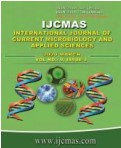


 National Academy of Agricultural Sciences (NAAS)
National Academy of Agricultural Sciences (NAAS)

|
PRINT ISSN : 2319-7692
Online ISSN : 2319-7706 Issues : 12 per year Publisher : Excellent Publishers Email : editorijcmas@gmail.com / submit@ijcmas.com Editor-in-chief: Dr.M.Prakash Index Copernicus ICV 2018: 95.39 NAAS RATING 2020: 5.38 |
Ventilator-associated pneumonia is a common complication in intensive care units, occurring in 9% to 24% of patients intubated for longer than 48 hours. This study aims to determine bacteriological profile of early and late onset VAP and its antibiotic susceptibility pattern. A prospective study was performed in the ICU setting of a tertiary care hospital (VIMS, Ballari) over a period of 1 year. ETA culture of 68 patients with a clinical suspicion of VAP were analysed by standard microbiological procedures. The present study showed GNB as the most common organism isolated. Pseudomonas spp (24.6%), followed by Klebsiella spp (22.8%), Acenitobacter spp (12.3%), former being predominant in early onset variety & the latter in the late onset VAP. Other organisms like E.coli, Citrobacter species, Proteus species, staphylococcus aureus and CONS are isolated in their decreasing frequency. Most of the organisms are resistance to Beta lactams and cephalosporins but sensitive to carbepenems. The Bacteriological culture of endobroncheal aspirates is helpful in the diagnosis and management of VAP. MDR is seen in most patients of VAP, Carbepenems are effective in treatment.
 |
 |
 |
 |
 |